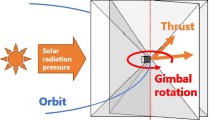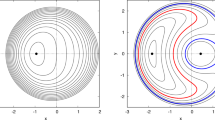Abstract
Numerical simulation of various stabilization scenarios of the motion a magnetically actuated satellite in the direction toward the Sun is performed. The satellite is equipped with solar sensors as the only attitude information source. The control algorithms are derived to achieve unambiguous stabilization in the direction toward the Sun while maintaining rotation around this direction despite the inability to identify this rotation using solar sensors. Extensive numerical simulation of the satellite’s motion with different configurations of the orbit and inertia distribution justifies the algorithm’s applicability and reveals its performance characteristics.






Similar content being viewed by others
REFERENCES
P. C. Hughes, Spacecraft Attitude Dynamics (Dover, New York, 2004).
G. Avanzini, E. L. de Angelis, and F. Giulietti, “Spin-axis pointing of a magnetically actuated spacecraft,” Acta Astronaut. 94, 493–501 (2014).
C. Chasset, S. Berge, et al., “3-axis magnetic control with multiple attitude profile capabilities in the PRISMA mission,” in 57th Int. Astronautical Congress, Valencia, Spain, October 2006, p. IAC-06-C1.2.3. https://doi.org/10.2514/6.IAC-06-C1.2.03
A. de Ruiter, “A fault-tolerant magnetic spin stabilizing controller for the JC2Sat-FF mission,” Acta Astronaut. 68, 160–171 (2011). https://doi.org/10.1016/j.actaastro.2010.07.012
H. You, Y.-W. Jan, and J.-R. Tsai, “Sun pointing attitude control with magnetic torquers only,” in 57th Int. Astronautical Congress, Valencia, Spain, October 2006, p. IAC-06-C1.2.01. https://doi.org/10.2514/6.IAC-06-C1.2.01
J. Kim and K. Worrall, “Sun tracking controller for UKube-1 using magnetic torquer only,” IFAC Proc. 46, 541–546 (2013). https://doi.org/10.3182/20130902-5-DE-2040.00126
A. I. Ignatov and V. V. Sazonov, “Stabilization of the solar orientation mode of an artificial Earth satellite by an electromagnetic control system,” Cosmic Res. 56, 388–399 (2018). https://doi.org/10.1134/S0010952518050015
A. Colagrossi and M. Lavagna, “A spacecraft attitude determination and control algorithm for solar arrays pointing leveraging Sun angle and angular rates measurements,” Algorithms 15, 29 (2022). https://doi.org/10.3390/a15020029
J. Cubas, A. Farrahi, and S. Pindado, “Magnetic attitude control for satellites in polar or sun-synchronous orbits,” J. Guid. Control Dyn. 38, 1947–1958 (2015). https://doi.org/10.2514/1.G000751
A. C. Stickler and K. T. Alfriend, “Elementary magnetic attitude control system,” J. Spacecr. Rockets 13, 282–287 (1976). https://doi.org/10.2514/3.57089
S. O. Karpenko, M. Yu. Ovchinnikov, D. S. Roldugin, et al., “One-axis attitude of arbitrary satellite using magnetorquers only,” Cosmic Res. 51, 478–484 (2013). https://doi.org/10.1134/S0010952513060087
L. M. Zelenyi, A. V. Gurevich, et al., “The academic Chibis-M microsatellite,” Cosmic Res. 52, 87–98 (2014). https://doi.org/10.1134/S0010952514010110
M. Yu. Ovchinnikov, D. S. Roldugin, et al., “New one-axis one-sensor magnetic attitude control theoretical and in-flight performance,” Acta Astronaut. 105, 12–16 (2014). https://doi.org/10.1016/j.actaastro.2014.08.017
D. S. Roldugin, S. S. Tkachev, and M. Yu. Ovchinnikov, “Satellite angular motion under the action of SDOT magnetic one axis Sun acquisition algorithm,” Cosmic Res. 59, 529–536 (2021). https://doi.org/10.1134/S0010952521100014
P. Alken, E. Thébault, et al., “International Geomagnetic Reference Field: The thirteenth generation,” Earth Planets Space 73, 49 (2021). https://doi.org/10.1186/s40623-020-01288-x
D. Roldugin, S. Tkachev, and M. Ovchinnikov, “Asymptotic motion of a satellite under the action of Sdot magnetic attitude control,” Aerospace 9, 639 (2022). https://doi.org/10.3390/aerospace9110639
Funding
This study was supported by the Russian Science Foundation, grant no. 22-71-10009, https://rscf.ru/project/22-71-10009/.
Author information
Authors and Affiliations
Corresponding author
Ethics declarations
The author declares that he has no conflicts of interest.
Rights and permissions
About this article
Cite this article
Roldugin, D.S. Extensive Numerical Simulation of a Magnetically Actuated Satellite’s Rotation around the Direction toward the Sun with Data from the Solar Sensors Only. Math Models Comput Simul 15, 792–801 (2023). https://doi.org/10.1134/S2070048223050083
Received:
Revised:
Accepted:
Published:
Issue Date:
DOI: https://doi.org/10.1134/S2070048223050083




